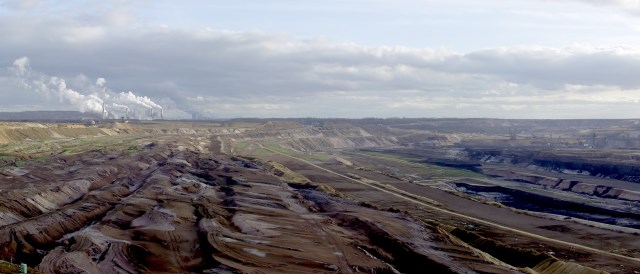In this final installment looking back on the first book on the Energiewende of 1980, Craig Morris looks at the many things the book gets right and wonders whether it might provide good reasons to finally call for a coal phaseout in Germany.

The dark side of domestic coal – the surface mine of Garzweiler. (Photo by Raimond Spekking, CC BY-SA-3.0)
It is astonishing how accurate this 1980 book on the Energiewende is. At a time when the largest functioning turbine, a community project launched in 1978 in Denmark (and still in operation), had only two megawatts and everything else was in the double-digit kilowatt range, the authors write of “three-megawatt wind turbines” with rotor diameters of “around 110 meters” – which is almost exactly where we were in 2000.
Photovoltaics was an application for NASA in the 1970s, and the authors say: “Notably, we have not included photovoltaics in our calculation, although prices have already begun dropping so fast that we might need to expect solar cells to play a role, especially in distributed power supply.” In 2012, Germany got 4.6 percent of its power from photovoltaics – and counting.
Did I say “distributed”? Man, these guys are all over distributed: “No central technology can be set up practically within a year to expand energy supply”; “Every capital-intensive, central technology has this drawback – from space travel to large coal plants”; “The current monopolist structures on energy markets have to be done away with.” Today, Germany has largely gone renewables with distributed wind turbines, solar arrays, and biomass facilities.
The book is prescient in many ways. The authors also believed that distributed biomass would be “hard for large corporations to monopolize,” but they point out that there could be competition between food and energy crops – a problem we still deal with today.
And then there is Passive House architecture, which allows homes in the German climate to do without central heating altogether. The authors did not use the term, speaking instead of “Type 4” architecture (the authors were typical German scientists with no sense for PR), but the efficiency levels are the same. And (writing in the late 1970’s!) they say, “It shouldn’t take the construction sector more than 10 years to start implementing this building type, which a Swiss firm already sells as a single-family home.” (It is worth noting that the German authors did not see Germany as a leader, often pointing instead to foreign countries, such as this study from the UK in the 1970s.) The first Passive House neighborhoods began going up in Germany in the early 1990s, and the EU’s Nearly Zero-Energy House, which will become the standard for new buildings at the end of this decade, is essentially Passive House.
In conclusion, the book is amazingly in line with contemporary German thought and events, perhaps because it did so much to shape it all. But in calling for 55 percent of its energy supply from “domestic coal,” the book also shows that Germans have been too fond of coal for too long.
Fortunately, the emotional attachment to “domestic coal” (heimische Kohle) also suggests how we might deal with the situation. If Germans have traditionally viewed coal as a domestic resource towards greater energy independence, they are not much different than the Americans, who are now being praised for lowering their carbon emissions by switching to shale gas – even as they export more coal. But the planet does not care where carbon is emitted.
Likewise, the French do not have so much nuclear power because they were more concerned about global warming decades ago, but because they have almost no coal or other domestic energy resources. The French went nuclear for military reasons and to have electricity from domestically stockpiled uranium fuel rods (admittedly, from imported uranium).
Germany’s old attachment to a domestic resource from the decade of two oil crises lives on today, but the focus is now much more on global warming than energy independence, and German hard coal consumption is largely no longer even domestic. Furthermore, the distributed coal-fired co-generation units that the study proposes are no longer in the foreground. Such units are to run on natural gas and, eventually, “green” gas (power-to-gas and biogas).
33 years after the publication of the original Energiewende book, its major shortcoming needs correcting. Critics of Germany’s Energiewende are right to hold the country’s feet to the fire and question its commitment to protecting the global climate. Germany needs to prove to detractors that it is switching from nuclear to renewables, not to coal.
Germany, let’s see the roadmap for your coal phaseout!
Craig Morris (@PPchef) is the lead author of German Energy Transition. He directs Petite Planète and writes every workday for Renewables International.
Germany, let’s see the roadmap for your coal phaseout!
After:
1. All nuclear out.
As nuclear can cripple the whole nation; unacceptable for just another method of electricity generation. History shows the chance is real.
4 reactors (3 Fuk., 1 Chren) exploded in 14,000 reactor years => 1 per 4000 years => with 8 reactors during 25 years chance 5%.
Assume German reactors are 5times more safe than still 1%!
.
2. A change in the EU Emission Trading System.
Closing coal now only implies that the CO2 emission rights will sold to another, who will use them for another process (chemical or coal plant in another country or ?).
So coal out now does nothing for the climate!